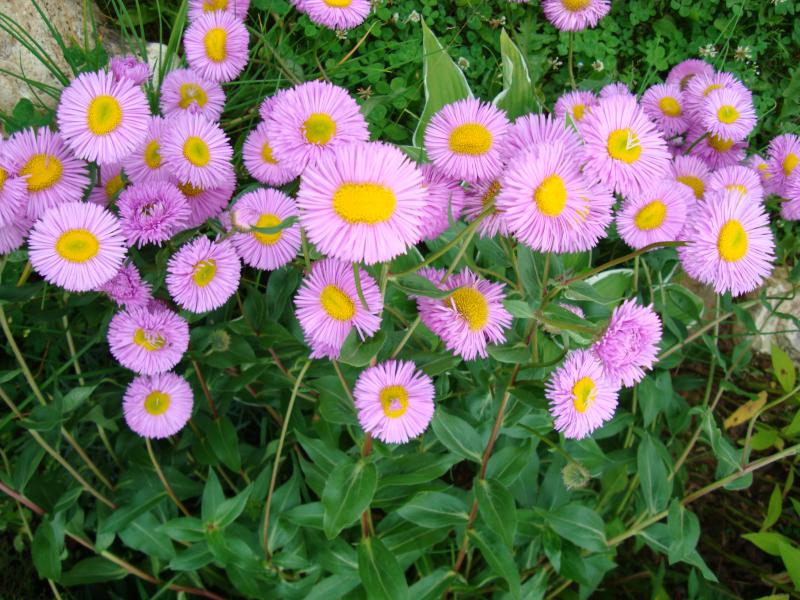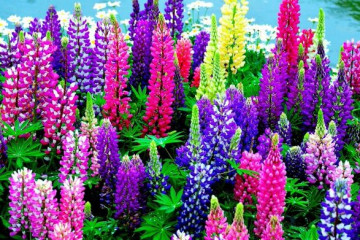Perennial small petals or Erigeron - planting and care
Content:
- The origin and appearance of the erigeron plant
- Types of erigeron or perennial petals
- Orange small petal (Erigeron aurantiacus)
- Beautiful small petal (Erigeron speciosus)
- Alpine small petals (Erigeron alpinus)
- Foreign small petals (Erigeron peregrinus)
- Compositae (Erigeron compositus Pursh)
- Soddy petals (Erigeron caespitosum Nutt)
- Small-petaled Karvinsky (Erigeron Karvinskianus, syn.E. mucronatus)
- Erigeron glaucus
- Erigeron Trifidus
- Small-petaled Miyabe (Erigeron miyabeanus Tatew. Et Kitam)
- Popular new varieties of perennial small petals
- Planting erigeron or small-petaled in open ground
This is a perennial crop, quite unpretentious in the cultivation process, which made it so popular among gardeners. At one planting site, it grows up to 5 years without losing its attractive appearance.
The origin and appearance of the erigeron plant
A plant with a height of about 70 cm with a straight and thin stem, which, depending on the variety, can branch intensively or weakly. The spreading of the bush is average. The shape of the leaves is oval or lanceolate, in length it can reach up to 18-20 cm.The color is intensely green.
Description of the erigeron flower
If we carry out a description of erigeron, then it is worth mentioning that some of its species are similar to a daisy. Flowers are located on top of the bush. More often - solitary, less often - collected in inflorescences. The petals are elongated, forming single-row or fluffy cups. Their color can be white, pink, lilac, blue or yellow. The core is quite bright and lush - it has a rich yellow color. The average size is 3 cm.
It throws out peduncles for a long time - almost all summer and the first half of autumn, the perennial small-petal will delight gardeners.
Erigeron Annuus
It is also called the one-year-old tank-skater (erigeron annuus). Plants of this variety have different heights. Depending on the conditions, the height can vary from 30 to 100 cm.
The annual small petals have white petals of a thin and narrow shape, framing a large yellow center.
Types of erigeron or perennial petals
The most beautiful is a bright pink variety called Pink Lotus. This color is the most elegant, although there are also intensely colored blues and lilacs.
Orange small petal (Erigeron aurantiacus)
Height about 45-55 cm. The inflorescence is a basket of numerous petals, which are narrow stripes of bright orange, purple or pink, lighter inside and approaching an intense shade along the outer edge.
Beautiful small petal (Erigeron speciosus)
This species (Erigeron speciosus) is taller - the stem reaches a height of 70 cm.The branches are straight and rough.
The closer to the roots, the larger the size of the leaves. Those located on the stems are smaller in size. They are lanceolate in shape.
Flowers are collected in baskets. Petals can be very diverse in color - white, blue, lilac, pale pink.
Alpine small petals (Erigeron alpinus)
A low-growing variety that does not exceed 30 cm in height. The tongue part has various shades of pink and lilac.
Foreign small petals (Erigeron peregrinus)
The variety is a perennial with a long rhizome and straight, not branched stems. The color is similar to the alpine species, that is, it combines a yellow core and pink reed petals.
Compositae (Erigeron compositus Pursh)
Semi-shrub species, forming a carpet of densely spaced flowers. The root system is powerful, well-branched, turning into a tree-like stem.
Soddy petals (Erigeron caespitosum Nutt)
This type of plant has a fairly branching trunk, which has gentle stems that lie on the ground. This erigeron blooms with liguli of white-pink or lavender, sometimes blue shades.
Small-petaled Karvinsky (Erigeron Karvinskianus, syn.E. mucronatus)
The small-petal Karvinsky (erigeron karvinskianus) is suitable for growing in flower beds and overhead structures - its height is only 15 cm.If you allow it to grow in open ground, it will take up to half a meter in diameter.
Outwardly, it is very similar to daisies. As soon as the flower opens, it is pink in color, turns snow-white as it blooms, and then takes on a reddish tint.
Erigeron glaucus
Glaucus reaches a maximum height of 45 cm, but in most cases no more than 25 cm.
The leaves are distributed evenly throughout the stem, in a checkerboard pattern.
The color of the flower is pale pink with a lilac tint, while the core is yellow.
Erigeron Trifidus (ErigeronTrifidus)
A short-growing flower with pubescent stems with oval small leaves. But the flowers, on the contrary, in the variety are very large, heavy and colorful.
Small-petaled Miyabe (Erigeron miyabeanus Tatew. Et Kitam)
A graceful plant, reaching a height of no more than 15 cm. It has a single stem. The wrapper is in the form of densely pubescent leaves.
Flowers usually consist of marginal and pistillate. The latter are arranged in two circles. Pistillate have a rich yellow color.
Popular new varieties of perennial small petals
This flower is a real decoration of the flower bed. It is suitable for ampel cultivation, therefore, it is used to decorate the facades of houses. A large number of varieties allows you to choose the right color of flowers, height and bushiness.
Erigeron Rose Treasure: Growing From Seed
Erigeron Rose Treasure is very similar to an aster in shape, and it is quite easy to grow it from seeds. The color of the flowers can be of different shades of pink with a constant yellow center.
Erigeron Foster Leibling
Erigeron Foster Leibling has rather wide rough leaves with towering powerful stems, densely covered with large flowers of intense pink color. Their diameter can reach 5 centimeters, and the number of petals is formed by semi-double inflorescences.
Daisy-leaved small petal
The peculiarity of this variety is that during flowering, the color changes from pink to white and then back to a rich raspberry color. The small-petal daisy-leaved blooms profusely, forming a dense cover of flowers in the flower bed.
Small-petaled Azur Beauty
The small petal variety erigeron Azur Beauty has a beautiful pinkish-bluish color of flowers, which are similar in shape to asters. Flowering is quite long - throughout the summer. The resulting seeds, which fall into the ground the next year, provide new seedlings of the plant.
Small petal Rose of July
The peculiarities of this variety are that their flowers have elongated marginal petals. The size of the inflorescence of the small-petaled Rose of July is quite large, which increases the decorative effect of the plant.
Planting erigeron or small-petaled in open ground
Planting the seeds of this plant directly into the ground is one of the options for getting it in your flower bed. In principle, Erigeron is very undemanding in planting and leaving in the open field. This is especially true for the temperate zone and southern regions. The seeds are laid in the ground when a fairly comfortable warm weather sets in at night.
If it is decided to grow it through seedlings, then the seeds must be planted in a box or special container at the beginning of March. In this case, seedlings appear in about 25 days. And young plants are planted in separate cups when they have two pairs of true leaves.
Small petals can be transplanted into the ground only when the threat of the return of night frosts has passed.
Growing erigeron or small petals from seeds
Features of growing through seedlings are as follows:
- seeds need to be buried a little when planting;
- stretch the film from above, forming a small greenhouse;
- keep at a temperature of about 10 ° C;
- water only with water at room temperature.
What is needed for planting erigeron or small petals
It should be borne in mind that the plant, although not capricious, still needs certain conditions, for example:
- before embedding seeds in the soil, baking powder well, make ridges in it and spill it with warm water;
- lay the seeds at a certain distance and lightly sprinkle them with soil;
- to create optimal conditions, cover with mulch on top.
Choosing the best place
Small petals enough unpretentious, but it is still better to choose well-lit areas. Here he will feel better.
As for moisture, you should not overmoisten it, although it is also undesirable to allow strong drying.
Top dressing of erigeron or small petal for lush flowering
When erigeron is planted in flower beds, planting and caring for it is so simple and not troublesome that it becomes a favorite compared to other flowers. It does not require top dressing, especially if the soil is not depleted. But, if the soil is very poor, then you can use a fertilizer formula containing potassium and phosphorus. These trace elements are most useful in the formation of a bud and flower. Application of top dressing is advisable only at the flowering stage.
Preparing for winter
The plant is frost-resistant, but in order for it to show itself with maximum decorative qualities next year, it should be cut off after flowering. At the same time, only 2-3 cm of the stem should be left above the ground.
Before the onset of frost, you need to cover the plant with spruce branches. This way the root system will be more protected.
Plant diseases and pests
The erigeron flower is heavily attacked by mold. Therefore, intensive hydration and watering are contraindicated for him.
Growing tips from experienced gardeners
Those gardeners who have experience in growing small petals advise:
- plant it along the edge of flower beds, using it as a curb element;
- this plant is well suited for alpine slides and multi-level plantings;
- if the height is more than 40 cm, you should tie up the bush, creating additional support for it.
Thus, those who at least once tried to grow erigeron become his fans, since it is visually quite effective, but at the same time unpretentious.





















